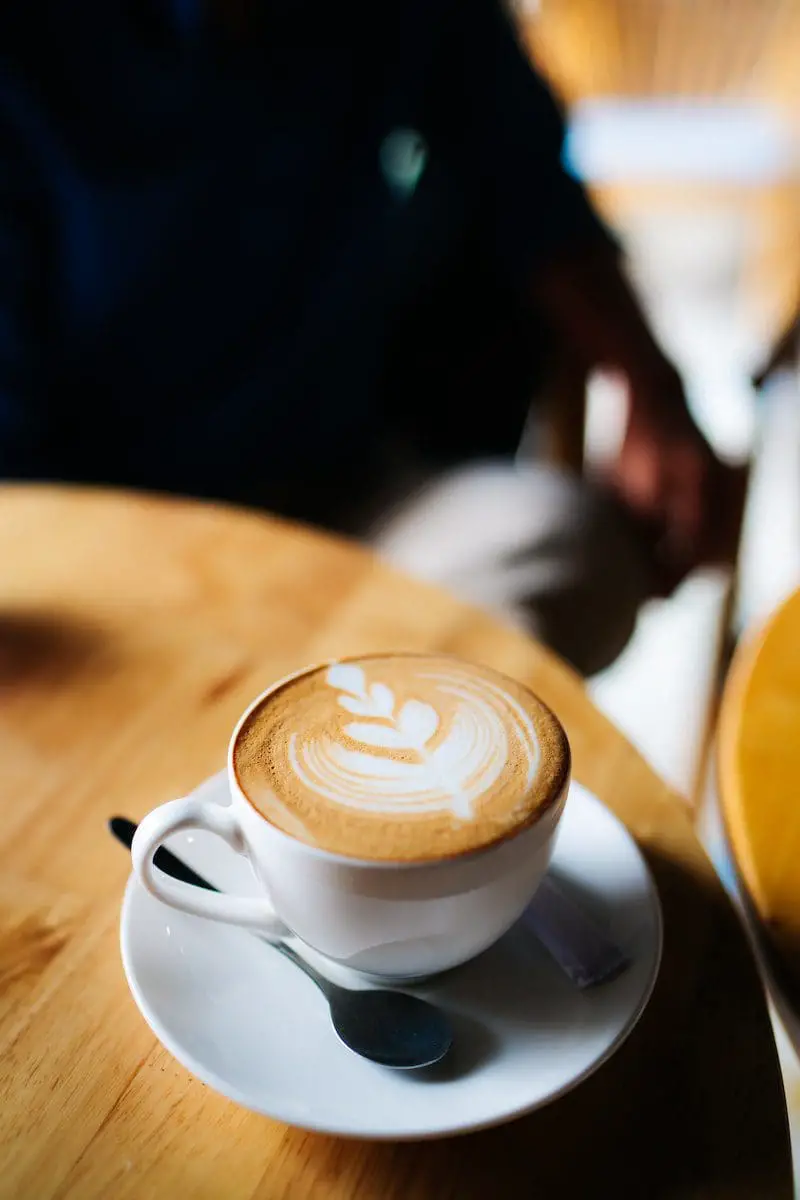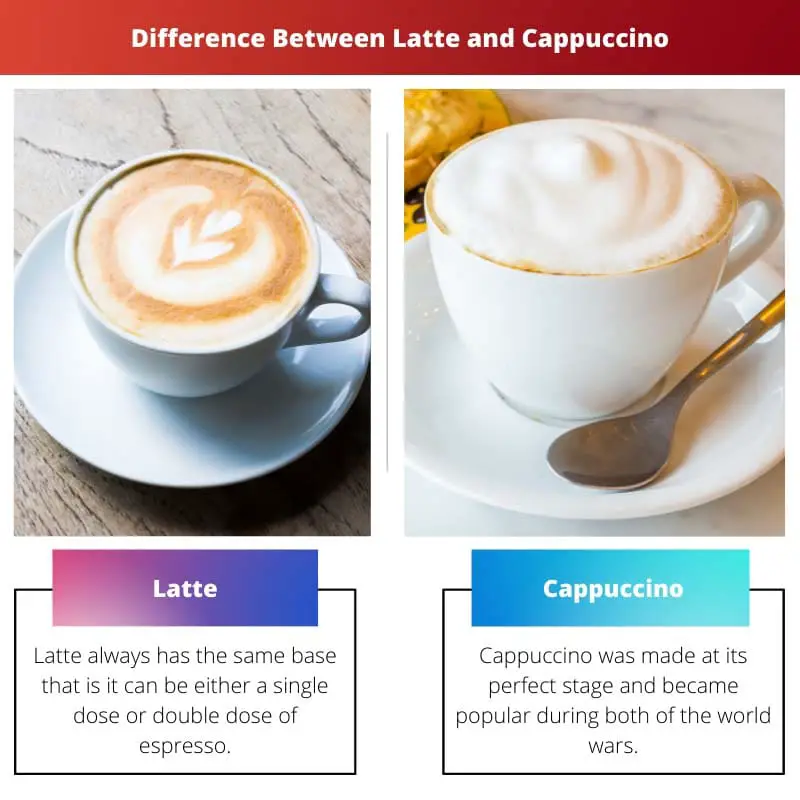Other than water or a basic drip of coffee, lattes and cappuccino are the most popular beverages in most countries around the world. Both of them are espresso drinks and are immensely loved by people. Both of them are like daily routine drinks for most people.
Both drinks have quite similar ingredients. Although, it depends on the espresso’s craftsmanship and that is what makes the two distinctive from each other. Both the drinks might look or sometimes even sound the same, but they do have many things uncommon.
Key Takeaways
- Lattes consist of espresso, steamed milk, and a small layer of milk foam, whereas cappuccinos contain equal parts espresso, steamed milk, and milk foam.
- Cappuccinos have a stronger coffee flavor than lattes due to their higher espresso-to-milk ratio.
- Lattes provide a smoother, creamier texture than cappuccinos because of their larger proportion of steamed milk.
Latte vs Cappuccino
The difference between a latte and a cappuccino is that a normal cappuccino drink contains all the ingredients, i.e. steamed milk, foamed milk, and espresso, distributed evenly while a latte has a much more quantity of steamed milk than a cappuccino with a layer of foam. All the ingredients in a cappuccino are layered equally, but in a latte, they are all stirred well.

Latte always has the same base, that is, it can be either a single dose or double dose of espresso. Then that espresso is stirred with some ounces of steamed milk.
This is done to get a rich and very creamy beverage that has a very subtle taste of an espresso. Usually, 1:2 is the typical ratio of espresso to steamed milk in a latte.
Cappuccino was made at its perfect stage and became popular during both world wars. It starts with layers of espresso at the bottom. Mostly in the united states, it is always two shots of espresso.
Then a layer of steamed milk is added to it, followed by a thick layer of foam. That layer of foam at the top makes the beverage rich and gives it a luxurious taste.
Comparison Table
| Parameters of Comparison | Latte | Cappuccino |
|---|---|---|
| Milk quantity | Latte contains more steamed milk. After evolving for over 20 years, a latte is majorly served with a sweet taste in it by adding flavors like vanilla or hazelnut. | Cappuccino has less quantity of steamed or textured milk. This is what gives cappuccino a very luxurious texture and adds taste to it. |
| Serving | Served in cups that have a better heat retention ability. | Served in a glass with a saucer. |
| Country of origin | latte originated from America | The origin-country of cappuccino in Italy. |
| Origin of name | Latte is referred to as coffee and milk in Italy. | Cappuccino comes from capuchin friars. |
| Layers | Latte does not have any layers as all the ingredients are stirred well. | Cappuccino is made by adding different layers distinctively. |
What is Latte?
Latte always has the same base that can be either a single dose or double dose of espresso. Then that espresso is stirred with some ounces of steamed milk. This is done to get a rich and very creamy beverage that has a very subtle taste of an espresso.
Usually, 1:2 is the typical ratio of espresso to steamed milk in a latte. Latte has a much more quantity of steamed milk than a cappuccino, along with a layer of foam.
Latte might have a basic formation, but the exact form of preparation may vary widely. It basically depends on the country and their culture. The popularity of a latte has exploded wildly during the last 20 years.
Since then, the latte has been altered endlessly, and now the most basic form of it is presented in a very sweet version of it by adding some flavours to it like vanilla or even hazelnut.

What is Cappuccino?
Cappuccino was made at its perfect stage and became popular during both world wars. It starts with layers of espresso at the bottom. Mostly in the united states, it is always two shots of espresso.
Then a layer of steamed milk is added to it, followed by a thick layer of foam. That layer of foam at the top makes the beverage rich and gives it a luxurious taste.
All the ingredients in a cappuccino are layered equally. It can be clearly said that a cappuccino is much stronger than a latte, and this is because it contains very less amount of milk in it, and the amount of foam is way much more than a latte.
It is widely said that when a perfect cappuccino is made, a barista is up to snuff. A correctly and perfectly made cappuccino has a liquid-to-foam ratio of 1:1.

Main Differences Between Latte and Cappuccino
- The main difference between Latte and Cappuccino is that all the ingredients in a cappuccino are layered equally, but in a latte, they are all stirred well.
- Latte contains more steamed milk, while Cappuccino has less quantity of steamed or textured milk.
- Latte is served in cups that have a better heat retention ability, while cappuccino is served in a glass with a saucer.
- Latte originated in America, while Cappuccino originated in Italy.
- Latte is referred to as coffee and milk in Italy, while Cappuccino comes from Capuchin friars.
- Latte does not have layers as all the ingredients are stirred well, but Cappuccino is made by adding different layers.

- https://www.sciencedirect.com/science/article/pii/S1382668909000350
- https://www.researchgate.net/profile/Rebeca-Jasso-Aguilar/publication/222347193_Sources_Methods_and_Triangulation_in_Needs_Analysis_A_Critical_Perspective_in_a_Case_Study_of_Waikiki_Hotel_Maids/links/59ebc7234585151983cb768a/Sources-Methods-and-Triangulation-in-Needs-Analysis-A-Critical-Perspective-in-a-Case-Study-of-Waikiki-Hotel-Maids.pdf#page=313

The information about the origin of the names of these drinks adds an interesting cultural aspect to the discussion.
Absolutely, it’s great to explore the linguistic and historical connections of lattes and cappuccinos.
The etymology of these terms certainly adds another layer of interest to the conversation.
The detailed breakdown of the components and serving styles of lattes and cappuccinos is truly enlightening.
I agree, it provides a more in-depth understanding of what goes into crafting these beverages.
The historical and cultural contexts of these coffee drinks really add depth to the appreciation of them.
I totally agree. It’s fascinating to dive into the origins and development of lattes and cappuccinos.
Absolutely, there’s so much more to these drinks than meets the eye.
The comparison table provided adds a great visual representation of the differences between lattes and cappuccinos.
Yes, it’s quite helpful to see the contrast in a clear, concise format.
Learning about the cultural and historical contexts of lattes and cappuccinos has certainly given me a newfound appreciation for these beverages.
I totally agree. It’s fascinating to delve into the complexities of these popular coffee drinks.
Absolutely, understanding the background of these drinks enhances the pleasure of enjoying them.
The origin stories and cultural associations with these drinks are quite fascinating.
Absolutely, the historical context adds a whole other dimension to the enjoyment of lattes and cappuccinos.
It’s intriguing to learn about the different ratios of steamed milk and foam in lattes and cappuccinos.
Indeed, it’s the subtleties in the ingredients that make such a difference in the taste of the two beverages.
The differentiation between lattes and cappuccinos is quite interesting. The discussion about the rituals and cultural aspects of how each drink is prepared is also captivating.
I agree. The distinction in the ratio of ingredients in each beverage is noteworthy.
Absolutely, the historical significance of the evolution of these drinks is fascinating as well.
The deeper understanding of the crafting and layering of these drinks is quite valuable for coffee enthusiasts.
Agreed, it provides a whole new level of appreciation for the art behind preparing lattes and cappuccinos.
The comparison of the serving containers based on heat retention is quite insightful.
Yes, it’s interesting to see how the choice of cup can affect the experience of enjoying these drinks.